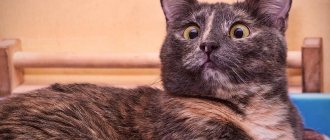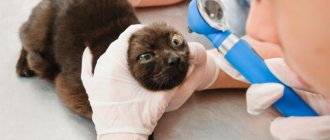Popular belief states that a cat has nine lives. True, this is just a belief. Specialists from the American Veterinary Insurance Society compiled a rating of the reasons for visiting clinics with cats. All kinds of wounds and injuries were on the seventh line of the gloomy “hot ten”. Not a single cat is immune from these diseases, and it is useful for the owner to know at least the basic rules and techniques for providing first aid to an injured pet. We talked about them with Doctor of Veterinary Sciences, Professor Sergei Aleksandrovich Yagnikov.
Most often, domestic cats suffer from wounds received in fights with fellow cats or dogs, as well as from the consequences of falling from a height. A non-specialist, based only on external signs of damage, can very rarely correctly assess the true nature of the injury and its danger to the life and health of the animal. Therefore, a responsible owner should not ignore any injury that occurs, even if it seems to him that the cat escaped with a few scratches and feels quite normal.
Cat wounds
Most often, cats have bitten, lacerated “battle wounds” received in fights with other cats or dogs. The most obvious sign of such wounds is damage to the skin, which requires appropriate treatment. First of all, the wound must be washed with a disinfectant. A regular solution of furatsilin is suitable for this. If you don’t have a ready-made solution, you can prepare it yourself by dissolving two tablets in a glass of warm boiled water. The surface of the wound is treated with this solution. If possible, remove fur from the area around the injury to prevent hair from sticking to the wound.
When the owner is unable to immediately deliver the injured cat to a veterinarian, she should be given an antibiotic. If the owner does not have a special veterinary antibiotic at hand, it can be replaced with a human drug, for example, Augmentin (amoxiclav). The antibiotic is given in a dosage of 12-15 mg per 1 kg of animal body weight twice a day. That is, an “average” cat that weighs 3 kg should receive about 50 mg of antibiotic at one time. And, of course, the animal needs to be shown to a veterinarian as soon as possible.
If the cat received a cut wound and started bleeding, then you need to do the following: take a clean, or better yet, sterile napkin, apply it to the surface of the wound and bandage it with moderate force. The pressing effect will reduce bleeding. If a large artery is damaged, it will most likely have to be sutured. Bleeding from small vessels can stop on its own, but treatment of such a wound still requires the supervision of a specialist.
Eye injuries are also common in cats and, unfortunately, in this case, the owner can do practically nothing himself. The damaged eye should be carefully washed with furatsilin solution and immediately consult a doctor.
Cats also have so-called abscesses. They usually develop as complications if the wound has not been washed with an antiseptic. Pathogenic microorganisms enter it and begin to develop, causing a cavity with pus to appear under the skin - an abscess itself. Externally, an abscess manifests itself as swelling, a “bump” on the skin and painful sensations when touched, since the cavity compresses the nerve endings. Sometimes the abscess opens spontaneously and pus is released from the wound. However, even in this case, it is better not to hope for the animal’s independent recovery. An abscess requires mandatory intervention by a veterinarian, because antibiotics alone cannot suppress a purulent focus. It is necessary to open and wash this cavity, install drainage in it and maintain it until the pathogenic process stops.
Treatment of uncomplicated infection
Treatment of urogenital chlamydia depends on the severity and extent of the process. If, against the background of infection with C. trachomatis, inflammatory diseases of the lower genital tract are detected - inflammation of the cervix (cervicitis), urethra (urethritis) or epididymis (epididymitis), then they speak of an uncomplicated chlamydial infection. Then the drugs of choice are azithromycin or doxycycline. By the way, studies have proven that azithromycin and doxycycline are equally effective. The effectiveness of first-line drugs in the treatment of uncomplicated urogenital chlamydia is 97–98%. Dual therapy with azithromycin and doxycycline is recommended for simultaneous infection with chlamydia and gonorrhea.
An alternative treatment regimen for chlamydial infection that is indicated when first-line drugs are intolerant or ineffective includes erythromycin or levofloxacin or ofloxacin. Sometimes preference is given to josamycin. The wide availability of generic azithromycin, moderate cost and high compliance (voluntary adherence by the patient to the prescribed treatment regimen) have become the basis for their mass use. Azithromycin is considered to be a more cost-effective treatment for chlamydia infection than alternative drugs. Erythromycin is less effective than azithromycin and doxycycline, mainly due to frequent gastrointestinal side effects, which may cause decreased compliance. Levofloxacin and ofloxacin have comparable efficacy to azithromycin, but are more expensive. Other fluoroquinolones have either been found to be ineffective in treating chlamydial infections or their use in such cases has not yet been fully studied.
Injuries in cats
Cats often fall from heights and are injured. Many ordinary people tend to consider a broken limb to be the most “terrible” of such injuries, but in fact, fractures in cats are well treated, and the animal has every chance of making a full recovery. True, fractures are also different. For example, an animal may suffer an intra-articular fracture, in which a crack runs along the surface of the “hinge” of the joint. Such fractures are the most complex, they require long-term treatment and sometimes lead to the development of arthrosis.
Very often, after a fall, the animal begins to drag its hind legs. This may be a sign not so much of paw fractures as of some kind of neurological injury, for example, a fracture of the spinal column. It occurs quite often in cats, and most often occurs at the level of the last thoracic and first lumbar vertebrae. Such a fracture is fraught with serious injury to the spinal cord and, unfortunately, the prognosis in this case is unfavorable.
The animal needs to be shown to a veterinarian as quickly as possible if:
- the cat does not eat or drink;
- limps heavily, does not support a limb;
- The cat developed bloody saliva, bloody discharge from the nose, and blood in the urine.
If the animal feels well, eats and drinks normally, but has a slight limp, then the owner may not rush to visit the doctor. Perhaps the cat just has a sprain or bruise that goes away quickly without treatment. But if lameness does not go away within a few days, then it is better to contact a veterinary clinic.
A rupture of the spinal cord may be indicated by the absence of pain. This is easy to check even at home. You need a suitable tool, such as tweezers, to squeeze the skin between the toes of the hind paw quite firmly. In a normal situation, such manipulation will cause pain - the cat will scream, try to scratch or bite. In this case, the prognosis will be favorable. But if the animal does not react in any way to such pain, then, most likely, its spinal cord is seriously injured. Even if the cat jerks its paw when squeezed, this does not mean anything. This is how the flexion reflex manifests itself, which can persist even with a complete rupture of the spinal cord. In case of spinal injury, only the feeling of pain can be considered a favorable factor that gives the animal a chance to recover.
Often, injuries associated with a fall from a great height lead to rupture of the diaphragm (the so-called partition between the chest and abdominal cavities). When it ruptures, part of the internal organs of the abdominal cavity, in particular the intestines and liver, can move into the chest cavity, where the lungs are located. Externally, such damage is expressed in the fact that the animal develops rapid breathing and cyanosis of the mucous membranes, because the lungs can no longer fully expand. The cat loses its appetite, and due to the pain caused by the injury, stiffness appears in its movements. But an accurate diagnosis can only be made using radiographic examination. If the diaphragm ruptures, the animal requires surgery, which can only be performed in a veterinary clinic.
The menacing face of disease
The danger of chlamydia began to be discussed seriously in the 90s of the last century. For a long time, almost all the troubles with women’s health were blamed on its consequences. How true are the warnings about the destructive effects of C. trachomatis?
In men, untreated chlamydia causes urethritis - inflammation of the urethra, as well as proctitis (inflammation of the rectal mucosa). Women bear a much heavier burden of the disease. Chlamydia, like a real subversive spy, penetrates the female body and begins vigorous activity. If the infiltrator is not identified and eliminated in a timely manner, a real disaster can occur.
Under the guise of imaginary well-being against the background of chlamydial infection, 15–40% of women develop inflammatory processes in the fallopian tubes, uterus and ovaries. Due to long-term inflammation, multiple adhesions are formed in the pelvis, which impair the patency and mobility of the fallopian tubes. About 20% of women become infertile, 18% develop chronic pelvic pain, and another 9% develop ectopic pregnancy. The prospects are not rosy, especially considering the high probability of asymptomatic chlamydia. Timely diagnosis will help avoid complications. The US Centers for Disease Prevention and Control - CDC - recommends annual testing for chlamydia for women under 25 years of age, as well as women at risk, regardless of age.
Pain relief for cats
Most injuries cause the cat to experience severe pain. The owner can independently reduce it by using pain relief therapy. Special veterinary drugs ketofen or nalbuphine are well suited for this purpose. But it is better not to give such popular painkillers as baralagin and analgin, especially in tablet form, to a cat, because they cause severe salivation in the animal. As a last resort, you can inject analgin by injecting 0.4 ml intramuscularly (dose for an average cat).
Also, in case of injury, traumatic shock is possible, one of the manifestations of which is vasospasm. This spasm has a very bad effect on the liver and kidneys. It can be removed with anti-shock therapy. The affected animal should be given corticosteroid drugs, for example, prednisolone (0.3-0.5 ml intramuscularly). But injections should only be considered as an emergency aid. At the veterinary clinic, anti-shock therapy will be continued using drip infusion.
Let's remember about rabies. Cats get rabies in the same way as dogs, so they also need to be vaccinated. It is very important that owners do not forget about this. Rabies can be transmitted to an unvaccinated cat even through a minor bite, and the owner or staff of the veterinary clinic can become infected from it. That is why, when going to the doctor, do not forget to take the animal’s veterinary passport with you. If a cat does not have a rabies vaccination, then the veterinary clinic may refuse to accept it, especially if the animal has a biting laceration received from an unknown location. The safety of people comes before the desire to save the injured animal. Moreover, many cases of rabies are registered in the Moscow region.
Subtle symptoms of chlamydia
Manifestations of chlamydia, or rather, their frequent absence, make a significant contribution to the successful spread of the disease. In approximately 50% of men and 80% of women, the infection occurs latently, without causing changes in well-being. It can be said that the minority who develop characteristic symptoms are the lucky ones who have the chance to quickly identify and treat an insidious disease.
In men, chlamydia is manifested by discharge from the urethra, pain in the lower abdomen, swelling of the scrotum and urinary disorders. Female chlamydia is characterized by:
- discharge from the vagina and urethra;
- abnormal bleeding;
- pain and bleeding after sexual intercourse;
- lower abdominal pain;
- urinary disorders.
The asymptomatic majority, not diagnosed and untreated in a timely manner, have many chances to experience all the insidiousness of chlamydia.
Causes of diseases
The phenomena that cause cats to suffer from various epidermal problems are everywhere. Due to their vulnerability and sensitivity, cats are more susceptible to multiple viruses and diseases than other animals. Not all owners realize that protecting their pet is a huge strategic task that requires thoughtful and balanced decisions.
Naturally, animals that roam freely on the street are more likely to contract various diseases. The owner cannot always see the problem and take the cat to the veterinarian, which significantly worsens the situation. But, in this case, you can also try to prevent everything and try to protect your pet from potential dangers.
Causes of diseases:
- Incorrectly composed diet;
- Bad ecology;
- Hormonal disorders;
- Sedentary lifestyle;
- Heredity;
- Ignoring treatment for parasites and vaccination.
Diagnosis of diseases
Having become familiar with the most common causes of epidermal diseases, the owner must be prepared all the time and know what to do if a problem arises . First of all, the owner is obliged to provide the pet for examination by a doctor so that the veterinarian can draw up an opinion on how likely it is to develop a certain disease.
Diagnosing any skin disease is quite difficult. A lot here depends not only on the veterinarian, but also on the information that the cat’s owner provides during the examination. It is also necessary to take into account that a number of studies and analyzes need to be carried out. They will be able to help achieve the desired indicators and identify the exact nature of the disease.
Diagnostics will help to create a clear treatment plan, identify the dangers of the disease and the degree of contagiousness . Therefore, you should not ignore the opportunities that provide you with professional and specialized treatment assistance.











